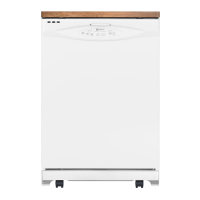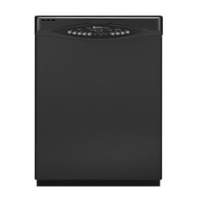SPECIAL TIPS Water Conditions
• Hard Water Deposit
For Best Results If an unusual amount of calcium is in the
• Hot Water is a Must water, a lime film or deposit may eventually
build up on the dishes and interior surface of
Hot water dissolves and activates the dishwasher. You may first notice this as
dishwashing detergent, dissolves grease on "cloudy" glasses.
dishes and helps dry"glasses spot-free. Make
certain all loads are washed in hot water. Refer To determine ff the film on the glasses is
to page 3 for more information, due to hard water, soak a glass
approximately 5 minutes in undiluted
• Use Enough Detergent white vinegar. Rinse and dry, If f'dm is
For proper soil removal, good drying results, removed, it is due to hard water (ff not
and to prevent filming, etching and spotting, removed, see Soft Water Etching).
an adequate amount of detergent must be
To correct:
used. We recommend 1 teaspoon of detergent
per grain of water hardness with a minimum of 1. Increase the amount of detergent used
3 teaspoons. Refer to pages 6-7 on adding according to the degree of water hardness
detergent. (see page 6).
• Use a Rinse Aid 2. Check the water temperature (see page 3).
Using a rinse aid improves drying results and 3. Use a rinse aid to improve the sheeting
reduces spotting and fdming. See page 7 for action of the water (see page 7).
instructions on using a rinse aid. To remove film from dishwasher interior, try
• Load the Dishwasher Properly one of the following:
To insure that all soiled surfaces get adequate 1. Remove with a damp cloth and a mild
wash action, carefully follow the instructions scouring powder.
for loading the dishwasher (pages 3-6). Make 2. Start empty dishwasher on Rinse & Hold
sure nothing extends above or below the racks cycle. During fill, open door and add 1/2
to interfere with the movement of the upper cup white vinegar to water. Allow
or lower spray arms. dishwasher to complete cycle. Do not
• Select the Proper Cycle use detergent. FoUow with a regular
The cycle needed depends on the amount of detergent wash.
food soil. See page 8 for cycle descriptions.
• Select Heat Dry
For improved drying select Heat Dry.
PAGE 10

